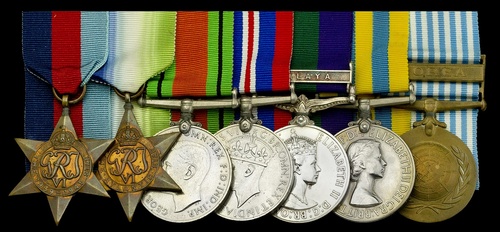
Auction: 18003 - Orders, Decorations and Medals
Lot: 527
A fine Second World War and post-war campaign group of seven awarded to Master Engineer J. K. Jackson, Royal Air Force, who flew operationally in Sunderlands of No. 88 Squadron over Malaya and off Korea
1939-45 Star; Atlantic Star; Defence and War Medals 1939-45; General Service 1918-62, 1 clasp, Malaya, E.II.R. (M. Eng. J. K. Jackson. (574763) R.A.F.); Korea 1950-53 (M. Eng. J. K. Jackson. (574763) R.A.F.); U.N. Korea 1950-54, generally very fine or better (7)
John Kirkby Jackson was born on 14 November 1922, the son of R. H. Jackson of Aingarth, Harwood, near Bolton; his father was Chairman of an advertising agency - Messrs. K. Jackson Limited of Manchester - and a member of the Lancashire County Council.
Young John entered the Royal Air Force as a Halton Apprentice in August 1938. He later qualified as a Flight Engineer and is believed to have served in Coastal Command during the Second World War.
Sunderlands over Malaya and Korea - Bandits, Fagots and Pirates
Remaining in the R.A.F. after the war, he was appointed a Master Engineer - a rare Warrant Officer aircrew rank - in March 1949, and it was in this capacity that he witnessed extended periods of active service in the Malaya and Korea operations. As a member of No. 88 Squadron, a Sunderland unit of the Far East Flying Boat Wing, he completed a spate of sorties out of Seletar in the Johore Straits and Iwakuni on the Inland Sea of Japan. He was latterly appointed the Squadron's Engineer Leader.
Of the Malaya operations - as recalled by Squadron Leader Alan Coles, also of No. 88 Squadron - 'Army Intelligence would determine an area of, perhaps, several square miles in which they believed the bandits were operating. We would be called in to strafe the area with machine-gun fire and drop 20lb. fragmentation bombs' ('Cold War Sunderlands' feature, Flypast, August 2018, refers). As also recalled by Coles, these bombs were fused and thrown by hand from the bomb-loading area: 'it was a bit scary!'. He continues:
'A more serious operation was our part in the Korean War. Sunderlands were deployed to a flying-boat base at Iwakuni on the Inland Sea of Japan, and used jointly with the U.S. navy's twin-engined Martin PBM Mariner flying-boats … We would support the U.S. Navy operation in the shores off Korea - up as far as the Yangtze River. These sorties were around 10 to 12 hours in duration. The intention was to create a blockade to deter reinforcements to Korea from China … There were day missions at low level, normally 100 to 500 ft., searching for any shipping which we would photograph for intelligence use. Occasionally we would see innocent looking trawlers, given away by an array of aerials and a small gun on the forward deck. These were believed to be tracking U.S. Navy ships. If we saw a puff of smoke from their foredeck, we would turn away sharpish! Night sorties were also staged at around 100-500ft under the cloud base' (ibid).
Of potential air-to-air opposition, Coles continues:
'The main enemy as far as we were concerned were Mikoyan-Gurevich MiG-15 Fagots flown by the Chinese Air Force - the U.S. navy had lost several of their Mariner flying-boats in the conflict. We were lucky, probably because we flew very low and never ventured above the clouds. It was unlikely a MiG would intercept us in such circumstances. We remained very vigilant, particularly in daytime. The gunners always tested their weapons before entering the operational area and kept their eyes peeled. We always knew when we had reached the northern end of our operating area: we saw the yellow tint on the sea from the sands coming down the Yangtze River - a signal to turn back' (ibid).
Such patrols aside, No. 88 also conducted Air Sea Rescue and anti-piracy sorties, in addition to undertaking V.I.P. flights. Jackson likely returned to the U.K.in late 1954 and he retired in 1962; sold with a file of copied research.
Subject to 20% VAT on Buyer’s Premium. For more information please view Terms and Conditions for Buyers.
Sold for
£750




